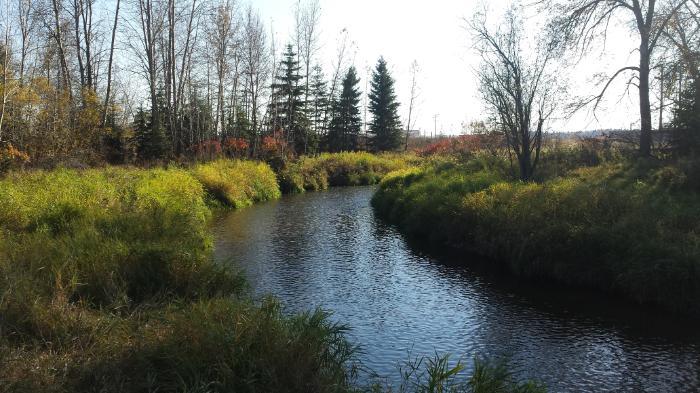Wastewater & Stormwater

Wastewater Treatment Plant
The raw wastewater goes through different cycles and/or processes before it is released as clean water. Treated wastewater leaves the plant area through a channel before being released into the Red Deer River. This creates better water quality for downstream users and prevents disease in human and aquatic life. The Wastewater Treatment Plant oversees the following areas:
- Wastewater Treatment Plant Processes
- Liquid Processing
- Solids Processing
- Source Control
Our Stormwater System
The City of Red Deer operates and maintains a sprawling network of storm infrastructure that has been built to ensure any stormwater drainage generated from catchment areas causes minimal nuisance, danger and damage to people, property and the environment. During a storm event rain or snowmelt flows over land to storm drains becoming stormwater which can collect and carry pollutants such as leaves, litter, pet waste, motor oil, detergents, fertilizers, and pesticides into our waterways. Stormwater receives minimal treatment before it enters our rivers and therefore it is important that we prevent it from being contaminated and negatively impact the river.
We are responsible for managing different types of stormwater infrastructure including:
| Storm Asset | Purpose |
|---|---|
| Curb & Ditch | Collects roadway and land drainage and carries it to a catch basin. |
| Catch Basin | Provides access for collected stormwater to enter a storm sewer. |
| Sewer | Carries collected stormwater to a waterway. |
| Manhole | Provides City staff access to complete maintenance on a storm sewer. |
| Outfall | Discharges stormwater to a waterway. |
| Dry Pond | Is a manmade depression that reduces surface flooding during a storm event. |
| Wet Pond | Is a manmade permanent pool that reduces surface flooding during a storm event. |
| Wetland | Is a manmade or natural pool of water that is a distinct ecosystem and can reduce surface flooding during a storm event. |
| Lift Station | Pumps stormwater uphill when there is not sufficient gradient to drain stormwater to a waterway by use of gravity. |
The following figure provides a general overview of the stormwater system:

The City provides the following services to enhance stormwater treatment and improve the terrestrial and aquatic health of our community:
- Reviews drainage plans for new developments
- Inspects and repairs damaged infrastructure
- Clearing of debris and sediment buildup in curbs, gutters and sewers
- Spring street sweeping and removal of roadway sediment and debris
- Removal of oil and grit from separator structures
- Responds to public complaints relating to storm issues
- Provides temporary safety measures during large storm events
To learn more about what can go into storm drains and how you can help to minimize any impacts refer to the following link: